
The Province of Upper Canada was a part of British Canada established in 1791 by the Kingdom of Great Britain, to govern the central third of the lands in British North America, formerly part of the Province of Quebec since 1763. Upper Canada included all of modern-day Southern Ontario and all those areas of Northern Ontario in the Pays d'en Haut which had formed part of New France, essentially the watersheds of the Ottawa River or Lakes Huron and Superior, excluding any lands within the watershed of Hudson Bay. The "upper" prefix in the name reflects its geographic position along the Great Lakes, mostly above the headwaters of the Saint Lawrence River, contrasted with Lower Canada to the northeast.
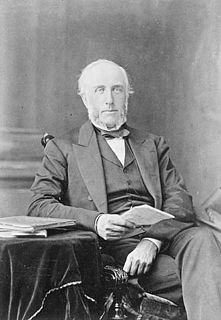
George Brown was a Scottish-Canadian journalist, politician and one of the Fathers of Confederation; attended the Charlottetown and Quebec conferences. A noted Reform politician, he is best known as the founder and editor of the Toronto Globe, Canada's most influential newspaper at the time. He was an articulate champion of the grievances and anger of Upper Canada (Ontario). He played a major role in securing national unity. His career in active politics faltered after 1865, but he remained a powerful spokesman for the Liberal Party promoting westward expansion and opposing the policies of Conservative Prime Minister John A. Macdonald.

John Galt was a Scottish novelist, entrepreneur, and political and social commentator. Galt has been called the first political novelist in the English language, due to being the first novelist to deal with issues of the Industrial Revolution.

Sir John Morison Gibson, was a Canadian politician and the tenth Lieutenant Governor of Ontario.

The Canada Company was a large private chartered British land development company, incorporated by royal charter on August 19, 1826, under an act of British parliament, given royal assent on June 27, 1825, to aid in the colonization of a large part of Upper Canada. Originally formed to acquire and develop Upper Canada's undeveloped clergy reserves and crown reserves which, in 1827, the Company acquired for £341,000 ($693,000) from the Province of Upper Canada.

George Stewart Henry was a farmer, businessman and politician in Ontario, Canada. He served as the Premier of Ontario from 1930 to 1934. Prior to becoming Premier, he acted as Minister of Highways, during which time Ontario greatly expanded its highway system. Henry continued the expansion of the highway system as Premier, however his party did not provide relief during the Great Depression and lost the 1934 election.

Gibson House is a historical museum in Toronto, Ontario, Canada. It is located on Yonge Street, in the North York Centre neighbourhood of the former city of North York.
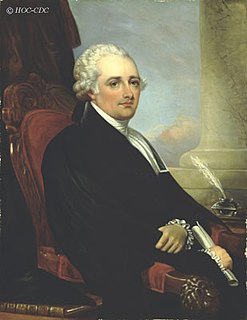
Sir David William Smith, 1st Baronet was a soldier and political figure in Upper Canada.
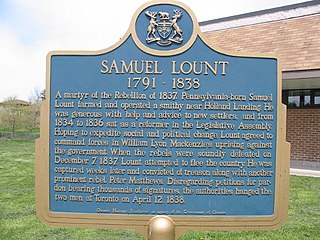
Samuel Lount was a blacksmith, farmer, magistrate and member of the Legislative Assembly in the province of Upper Canada for Simcoe County from 1834 to 1836. He was an organizer of the failed Upper Canada Rebellion of 1837, for which he was hanged as a traitor. His execution made him a martyr to the Upper Canadian Reform movement.

The Township of Norwich is a municipality located in Oxford County in Southwestern Ontario, Canada. The preferred pronunciation of the town name is NOR-witch, which differs from the pronunciation NORR-ij used for the city of Norwich, England. The origin of Norwich, Ontario, is more likely Norwich in upper New York State, the area from which the pioneering families emigrated in the early 19th century, where the community was known as Norwichville.
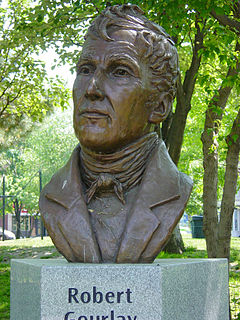
Robert Fleming Gourlay was a Scottish-Canadian writer, political reform activist, and agriculturalist.

Thomas Ridout was a political figure in Upper Canada.
John McGregor was a businessman and political figure in Upper Canada.
Colonel Joel Stone was a United Empire Loyalist and the founder of Gananoque, Ontario.
Charles Rankin, was an early Irish-born and Scottish-descended settler and land surveyor in Upper Canada. He is significant due to his role in the surveying and early settlement of large areas of Upper Canada, including much of the Bruce Peninsula and south shore of Lake Huron, and notably the city of Owen Sound. Born in 1797 at Enniskillen, County Fermanagh, Ireland, he died in either 1886 or 1888 in Owen Sound, a city whose founding he had been instrumental in.

Augustus Jones was an American-born Upper Canadian farmer, land speculator, magistrate, militia captain and surveyor. Jones trained as a surveyor in New York City, and fled as a United Empire Loyalist to Upper Canada. In Upper Canada, he worked as a crown surveyor in the Nassau District, where he quickly rose to the position of Deputy Surveyor General, the highest position in a district of Upper Canada. He occupied that position from 1789 informally, and 1791 formally, until his retirement in 1799. During that time he laid down many of the township boundaries in the Niagara Peninsula and on the north shore of Lake Ontario. He led various teams that cut many of the first sideroads and concession roads into these areas, facilitating their settlement by European and American immigrants. Jones also surveyed the routes for Dundas Street and Yonge Street, and supervised their construction. After his retirement, Jones farmed first in Saltfleet Township, later moving to Brantford and finally an estate outside Paris named Cold Springs, where he died in 1836.
David Gibson may refer to:
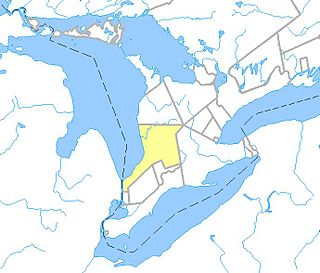
The Huron Tract Purchase also known as the Huron Block, registered as Crown Treaty Number 29, is a large area of land in southwestern Ontario bordering on Lake Huron to the west and Lake Erie to the east. The area spans the counties of Huron, Perth, Middlesex and present day Lambton County, Ontario in the province of Ontario.
Richard Birdsall was a British born Upper Canadian land surveyor, land agent, politician, justice of the peace, and militia officer. Born in rural Yorkshire, England, he emigrated to Upper Canada in 1817, settling initially in the Township of Vaughan. Birdsall received a license for land surveying in 1819 and began his career that same year. Birdsall would go on to survey many areas in Newcastle District as well as other parts of what is now Southern Ontario, establishing the boundaries of many townships of the province and laying out the roads and farming lots within them.

Alexander Maitland was a lieutenant governor in the US state of Michigan from 1903 to 1906.
















